Superfund Accomplishments Quarterly Report - Fiscal Year 2023
EPA’s Superfund Accomplishments Report highlights the important work of EPA staff and partners to clean up the nation’s most contaminated land and respond to environmental emergencies and natural disasters. Superfund cleanups protect human health and the environment, while also supporting community revitalization efforts and economic opportunities through redevelopment.
With its quarterly updates, EPA’s Superfund Accomplishments Report publishes stories as they happen. Please check back regularly for new stories and program highlights!
Table of Contents
- In the News
- Protecting Human Health and the Environment
- The Infrastructure Investment and Jobs Act and Superfund
- Communities as Key Partners in the Cleanup Process
- Addressing Lead Contamination at Superfund Sites
- Fiscal Year 2023 – Quarter 1, Quarter 2 and Quarter 3 Reports
In the News
The Superfund Accomplishments Report isn’t the only place you can read about the great work taking place. The Superfund program often shares its biggest successes through press releases and other national announcements.
Click on the headlines below to read our most notable recent Superfund success stories!
- EPA recognizes excellence in VA Superfund cleanup
- EPA Offering Free Job Training Opportunity in New Bedford
- EPA Updates Superfund National Priorities List, Adding Sites in Indiana, Louisiana, and Oklahoma
- EPA to conduct Climate Vulnerability Assessment at Smurfit-Stone Mill site in Frenchtown, Montana
- U.S. Administration Announces Additional $1B in Infrastructure Law Funds to Start New Cleanup Projects and Expedite On-going Cleanup Work Across the Country
- EPA Celebrates Career Training, Job Opportunities With 20 Superfund Job Training Initiative Graduates in Omaha, Nebraska
- EPA Takes Important Step to Advance PFAS Strategic Roadmap, Requests Public Input and Data to Inform Potential Future Regulations under CERCLA
Protecting Human Health and the Environment
Legacy pollution from past industrial activity impacts thousands of sites across the country, often in communities already overburdened with other environmental stressors. The Superfund program cleans up these sites and ensures that the remedies remain protective for years to come.

Deleted Part of Superfund Site in Maine Now Hosts a Fire Station
EPA is supporting the town of Corinna with its plans to reuse two parcels at the partially deleted Eastland Woolen Mill Superfund site in Penobscot County, Maine. The parcels have been cleaned up; land use restrictions require EPA approval before reuse. The agency approved the town’s plans and specifications for the construction of a new fire station for the town after ensuring that excavation depths were appropriate and that any excess soil was managed properly. A second lot is also being considered for future development. These reuse projects add to substantial redevelopment already realized at the site, including a 20-unit senior housing facility and recreation opportunities such as walking trails and a community bandstand.
Proposed Consent Decree Amendment for Colorado Superfund Site Resolves Outstanding Reimbursement
The proposed amendment will fully and finally resolve a longstanding requirement for the U.S. Army to reimburse EPA costs at the Rocky Mountain Arsenal Superfund site, as directed by the site’s 1989 Federal Facility Agreement. The amendment was signed by all involved parties in summer 2023, with the U.S. Department of Justice lodging it in federal court in September 2023. An October 2023 notification in the Federal Register initiated a 30-day public comment period, which ended without any comments. Once DOJ authorizes payment from its judgment fund, EPA will receive slightly more than $10.2 million into a site-specific special account. The lack of sufficient payment from the U.S. Army dates to 2015, if not earlier. The settlement will fund all future EPA costs for overseeing the current and any future CERCLA actions, ensuring that the cleanup remedies function as intended and protect human health and the environment.

The Infrastructure Investment and Jobs Act and Superfund
The Infrastructure Investment and Jobs Act invested $3.5 billion in environmental remediation at Superfund National Priorities List sites and reinstates the Superfund chemical taxes, making it one of the largest investments in American history to address the legacy pollution that harms the public health of communities and neighborhoods.
Learn more about how Superfund and impacted communities are benefitting from the Infrastructure Investment and Jobs Act.
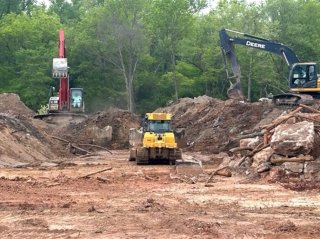
Superfund Cleanup in Oklahoma Becomes One of the First Cleanups Completed Using Infrastructure Funding
In May 2023, EPA and the Oklahoma Department of Environmental Quality completed physical construction of a remedial action funded by the Infrastructure Investment and Jobs Act at the Wilcox Oil Company Superfund site in Bristow, Oklahoma. The action, which cost around $7 million, excavated about 58,000 tons of materials from nine Wilcox and Lorraine refineries and took them to off-site facilities for disposal. EPA reduced disposal costs by about $1.3 million by using a stabilizing agent after a pilot project proved effective. The agent reduces the leaching of lead from contaminated soil, allowing for the soil to be disposed of as non-hazardous waste. EPA is now supporting the city of Bristow’s efforts to reuse the cleaned-up site property.
Communities as Key Partners in the Cleanup Process
EPA works closely with communities across the country as part of Superfund’s Community Involvement Program to enable community members to get involved and stay informed.
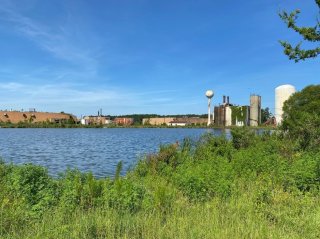
Superfund Water Line Expansion Benefits South Carolina Community
EPA is helping provide clean water to residents in Darlington County, South Carolina, affected by the Galey and Lord Plant Superfund site. Through a cross-program EPA team that included Region 4’s Superfund and Water divisions, among others, the agency leveraged resources from its Drinking Water State Revolving Fund grant resources to provide about $6 million to the Darlington County Water & Sewer Authority to assist with the water-line expansion. The expansion will deliver clean water to people whose wells have been contaminated with per- and poly-fluoroalkyl substances stemming from wastewater sludge at the site.
A textile mill and finishing facility was active on site. Plant operations generated wastewater sludge that was applied to about 300 agricultural fields in a tri-county area. Through Superfund site inspection and sampling authorities, the South Carolina Department of Health and Environmental Control, in coordination with EPA, identified private wells contaminated with PFAS at levels above the maximum allowable drinking water amount. EPA installed a water filtration system, providing residents with potable water while the municipality installs water lines.
In September 2023, EPA Region 4 facilitated a public meeting to kick off the site’s remedial investigation and feasibility study. More than 50 community members and several city, county and state representatives attended the meeting.
Addressing Lead Contamination at Superfund Sites
Health Fair in Missouri Includes Lead Poisoning Prevention Event

In collaboration with federal, state and local partners, EPA hosted a lead poisoning prevention outreach event at the Washington County Health Fair in September 2023. The county includes four Superfund National Priorities List sites (Potosi, Old Mines, Richwoods and Furnace Creek) where lead is the main contaminant of concern. The event raised awareness of free resources available for county residents: lead testing and cleanup for residential yards, testing and filters for lead-contaminated private drinking water wells, and blood-lead testing for children and adults through the Agency for Toxic Substances and Disease Registry. The effort resulted in direct outreach to 135 people. The state and Washington County Health Department performed about 40 free blood-lead tests.
Fiscal Year 2023 - Quarter 1, Quarter 2 and Quarter 3 Reports

EPA Supports Interagency Response to Ecosystem Threat Near Montana Superfund Site
EPA participated as a strategic member of an interagency team seeking to understand why fish populations are declining in a stretch of the Clark Fork River directly downstream of the Silver Bow Creek/Butte Area Superfund site. The other agencies in attendance included the Natural Resource Damage Program and the Montana Department of Environmental Quality. All participating agencies collect data on the Clark Fork River and are knowledgeable about potential causes of fish population decline. The interagency team is still working towards identifying a specific cause or cumulative causes to determine the best mitigation response.
The Infrastructure Investment and Jobs Act Funds Significant Cleanup Actions in Michigan
Funding from the Infrastructure Investment and Jobs Act supported the cleanup of over 115,000 tons of highly contaminated soil from the 52-acre Velsicol Chemical Superfund site. About $23 million in Infrastructure funding has been allocated for cleanup actions at this site. These actions will include additional excavations of contaminated soil to further restore the environment and protect adjacent communities.
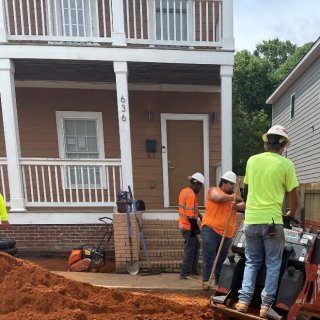
Committed Community Involvement Efforts Pay Off in Atlanta
Site teams successfully transitioned from a time-critical removal action to long-term remediation of the Westside Lead Superfund site thanks to exceptional community involvement efforts that secured access agreements from homeowners to continue cleanup actions. The TCRA began in 2019. It concluded with the removal of 46,071 tons of contaminated soil from 210 properties. EPA met with about 300 residents during door-to-door community outreach to obtain the access agreements to ensure the cleanup can continue.
Interagency Coordination Supports Community Lead Education in Missouri
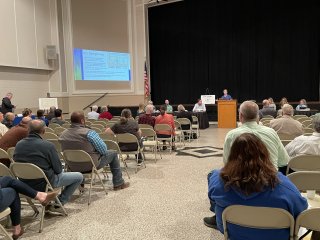
EPA coordinated with local, state, and federal agencies to host a successful community event to inform residents about lead contamination in their community and how they can reduce their risk of exposure. Past mining operations at the Oronogo-Duenweg Superfund site resulted in significant lead contamination that impacted residential properties, drinking water wells and recreation areas. EPA worked with the Missouri Department of Natural Resources, the Agency for Toxic Substances and Disease Registry, the U.S. Fish and Wildlife Service, and tribal partners, among others, to organize the event, which included free blood testing for lead in children ages six and under and pregnant or nursing mothers, resulting in further identification of lead contamination exposure. The interagency coordination enabled EPA to reach several multilingual groups and build a larger local network of relationships across the county that includes about 190 community members and organizations.
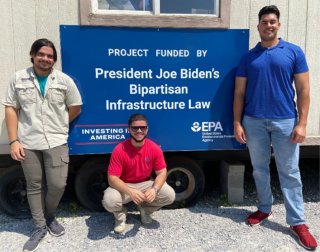
Student Volunteers Assist EPA with Lead Cleanup in Tennessee
This past summer, EPA’s Region 4 Office on-boarded three student volunteers from the University of Puerto Rico to assist with remediation work at the Southside Chattanooga residential lead cleanup. The students participated in the U.S. Department of Education’s Minority Science and Engineering Improvement Program. This is the first time EPA’s Region 4 Office has collaborated with MSEIP. During the summer, the students assisted with a range of community involvement activities, sampling events, and pre- and post-remedial planning and organization efforts as well as outreach efforts with Latinx residents and community organizations. The enriching experience will benefit the students as they pursue their science degrees.
Superfund Cleanup in Connecticut Considers Coastal Resiliency
EPA is implementing a significant remedial construction project involving the excavation of more than 100,000 cubic yards of contaminated soil from over two dozen properties surrounding the Raymark Industries Superfund site. Contamination from the now-defunct automotive parts manufacturer was dumped in low-lying properties such as marshes and wetlands. In addition, EPA has incorporated a 1-foot increase to the restored property elevation at highly trafficked waterfront locations such as public access points. The additional foot of clean material will combat the frequency and severity of routine flooding.
EPA Uses On-Site Resources to Reduce Maine Cleanup’s Carbon Footprint
EPA eliminated the need for 15,000 truckloads of off-site material by using on-site resources for cleanup actions at the Callahan Mining Corps Superfund site. EPA has worked to reduce the cleanup’s impacts on the community and local infrastructure by sourcing on-site materials such as crushed clean rock and excavated clean dirt for cleanup materials instead of hauling material from out of town. The use of the on-site materials was made possible by a settlement agreement between EPA, the local government, and the current property owner.
Continued Redevelopment at Massachusetts Superfund Site Will Bring Clean Energy to Communities
EPA is overseeing construction of a 4-megawatt solar generation facility at the Industri-Plex Superfund site using previously undevelopable capped waste disposal areas at the site. The facility will provide clean energy to the nearby city of Somerville. When it comes online, 7.6-megawatt of solar energy will be generated at the site; 3.6-megawatt of the energy will support previously authorized rooftop solar projects. EPA worked closely with ECA-Solar, Standard Solar, Inc., the property owner, the city of Woburn and the Massachusetts Department of Environmental Protection to facilitate the project.
This solar project and many of the previous projects at the site illustrate EPA’s continued commitment to supporting safe redevelopment and the return of cleaned-up Superfund properties to productive reuse for municipalities and communities.
Cleanup Technologies Support Significant Contamination Removals in California
The Brown & Bryant, Inc. (Arvin Plant) Superfund site was once a pesticide and herbicide manufacturing facility that contributed to groundwater contamination that includes Dinoseb, a banned hazardous waste. In 2017 and 2021, EPA took steps to optimize the existing treatment system to greatly increase the rate of contaminant extraction, increase the ability to contain the contaminant plume, and treat and dispose of the wastes on site. As of May, EPA had removed about 2,100 pounds of toxic gases known as volatile organic compounds from the site through a groundwater remediation system and soil vapor extraction. These innovative on-site cleanup technologies have saved taxpayers an estimated $1 million in transportation and disposal costs, and dramatically reduced greenhouse gas emissions and the risk of spills and traffic accidents associated with the site. EPA maintains a meaningful relationship with communities impacted by the site and recently invited a local group, Committee for a Better Arvin, to tour the site and learn more about EPA’s cleanup efforts.
Coordinating Cleanup Logistics with Communities in Texas
Since November 2022, EPA has excavated nearly 12,000 cubic yards of dioxin-contaminated soil from the San Jacinto River Waste Pits Superfund site. The soil was removed from the site’s Southern Impoundment area, which is next to two active businesses. EPA worked closely with the potentially responsible party to perform cleanup actions during off-peak traffic and working hours to lessen the burden on local workers and community members. The Southern Impoundment is being remediated to meet business and commercial risk standards, in line with surrounding uses.
Tackling PFAS contamination at the Tucson International Airport Area Superfund site in Arizona
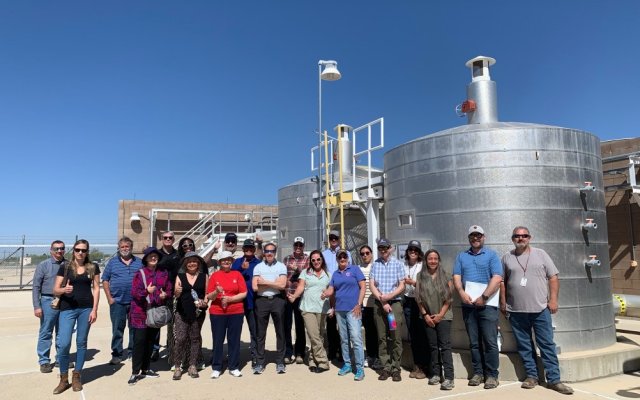
In March, the state of Arizona received $25 million in emergency funding to address contamination from per- and polyfluoroalkyl substances, or PFAS, to preserve the Tucson Area Remediation Project remedy, which provides an essential supply of treated water to surrounding underserved communities. Members of the Unified Community Advisory Board joined EPA staff and state partners on a tour of recently installed reclamation infrastructure and the Tucson Airport groundwater treatment system. The UCAB consists of community members and families who have lived and worked near the site for several generations. UCAB has participated in the Superfund cleanup process for more than 25 years and still meets on a quarterly basis with EPA to provide input for the ongoing improvements to the remedial actions.
Joining a "Community Baby Shower" to Connect with Community Members
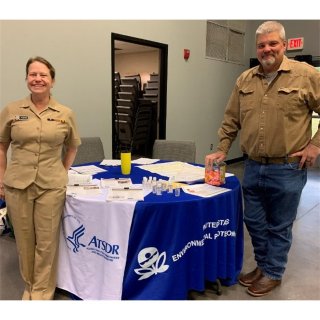
In fall 2022, Cherokee County officials in Kansas invited EPA and the Agency for Toxic Substances and Disease Registry to a “community baby shower” to engage with sensitive populations about risks associated with lead exposure. Cherokee County has two Superfund sites and an abundance of lead contamination across several environmental media, including soil, groundwater, and sediments. Conversations with community members, partners, and stakeholders led to four families signing up to have their yards sampled for lead. The event also allowed EPA to connect more closely with local partners, bolstering EPA’s community involvement efforts.
Superfund Pilots Additional Successful Community Workshops
In Fall 2023, EPA piloted four more Superfund Community Workshops, at the Lower Neponset River Superfund site in Boston, Massachusetts, and at the Meeker Avenue Plume Superfund site in Brooklyn, New York. The workshops promoted community involvement earlier in the cleanup process and enabled communities to engage with EPA and the cleanup process more meaningfully. EPA offered in-person, hybrid, and virtual options for communities to attend the workshops, which featured EPA partner presenters, community guest speakers, listening sessions, and engaging videos. EPA is evaluating data to improve the workshops and make them a lasting component of Superfund’s community involvement program.
Building Community Capacities in Atlanta, Georgia
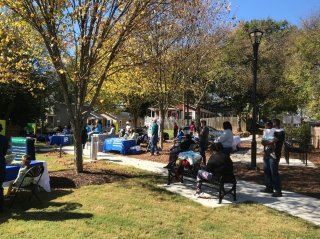
EPA enhanced community involvement efforts at the Westside Lead Superfund site after conducting a Technical Assistance Needs Assessment that resulted in recommendations for ways the Agency could improve its outreach efforts. The EPA site team collaborated with federal and local agencies to increase community capacities, hosting a lead education and awareness event and conducting door-to-door outreach that resulted in 42 signed access agreements to sample residential properties. EPA joined the City of Atlanta Councilman’s Westside Walk where community members walked with federal and local government officials and discussed their thoughts and concerns about the site. The site team continues to make strides in keeping the community well informed about the cleanup efforts by attending neighborhood planning meetings.
Community Involvement Efforts Pay Off with Public Comments
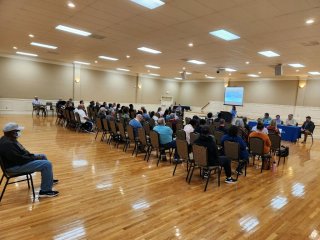
EPA received over 200 comments on the recent addition of the Hercules Inc. site in Hattiesburg, Mississippi, to the National Priorities List, demonstrating exemplary community involvement by the EPA site team. The site is a former chemical manufacturing facility that leaked hazardous substances into the environment and contaminated the surrounding area. EPA worked diligently to share information and resolve community concerns about site cleanup actions. EPA engaged the community through two hybrid meetings and extended the listing’s public comment period by 30 days to provide community members with more opportunities to comment. EPA published several notices in the local newspaper, provided a fact sheet with instructions on how the public could comment on the proposed listing, posted pre-recorded presentations from each public meeting to the site’s webpage, and published over 550 fact sheets and post cards for residents within a half-mile radius of the site prior to each of the meetings.
Ensuring Remedies are Resilient to Climate Change at a Mississippi Superfund Site
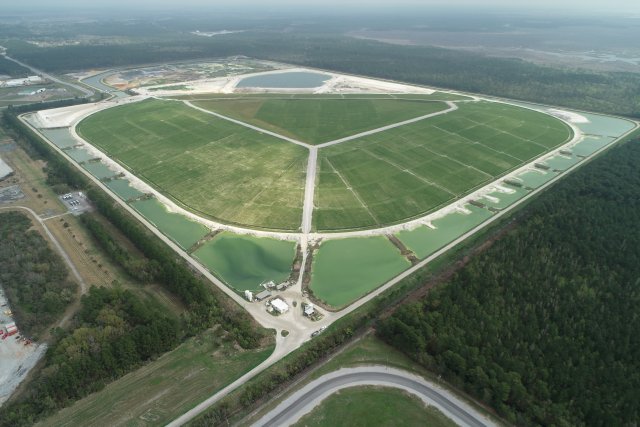
At the end of February 2023, EPA finished capping all 170 acres of the East Gypsum Stack at the Mississippi Phosphates Corporation Superfund site with a geosynthetic cover system. This cover system allows rainwater to be diverted as clean runoff (without treatment) to a local bayou. MPC made fertilizer at the facility from the 1950s to 2014, and produced a gypsum waste product that was made into stacks. Reducing the amount of water that must be treated at the site resulted in a cost savings of about $6 million per year.
The geosynthetic turf was installed more quickly than traditional remedies, requires less maintenance, and is more resilient to extreme weather conditions, including drought cycles, degradation from ultra-violet rays, heavy rains with concentrated flow, and hurricane force winds.
Implementation of this system saved an estimated 42,700 truck trips for hauling cover soil, which reduced the cleanup’s environmental carbon footprint. The geosynthetic turf cover system had not been used previously at any NPL site. It has proven to be a reliable remedial tool and has recently been selected for use at other Superfund sites.
Using Technology to Better Involve Community Members in Cleanup Process in Texas
In November 2022, EPA launched The Lane Plating Removal Action Hub, which offers real-time data on environmental sampling, air monitoring, and historical weather, along with an array of interactive map tools and widgets. This innovative Hub uses geospatial technology to foster community engagement at the Lane Plating Works, Inc. Superfund removal action site in Dallas, Texas. Using a map of air monitoring locations, frontline community members can visualize their proximity to the stations and view current air quality readings, categorized as good, moderate, or poor. This information automatically updates an alert panel, which details local air conditions and actionable steps for field personnel and residents. To build trust and ensure transparency, the application provides the public with access to multi-media visuals, such as high-definition drone videos and photos, as well as downloadable reports and tables relating to soil sampling, air monitoring, and existing site conditions.
